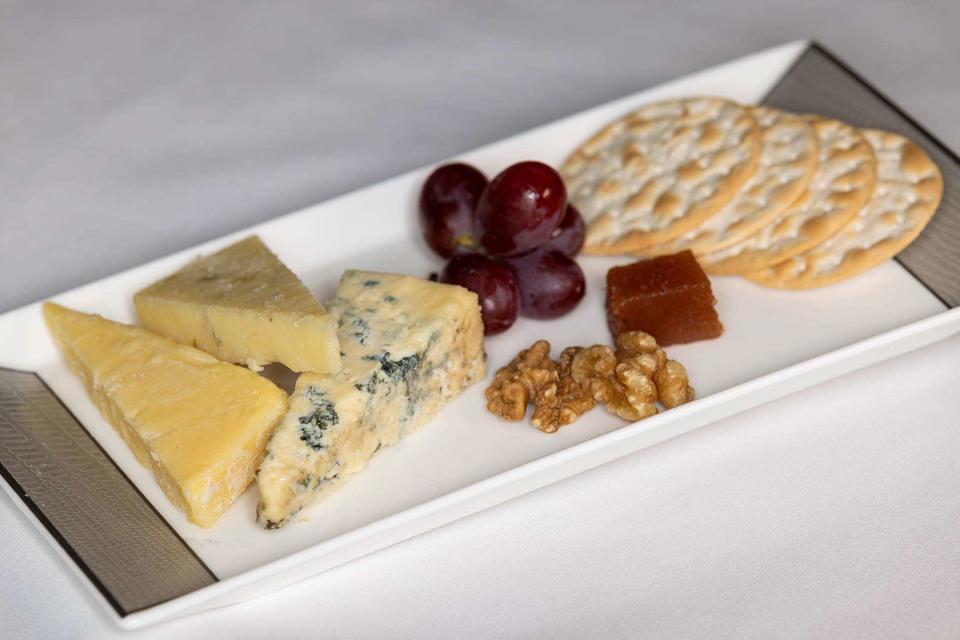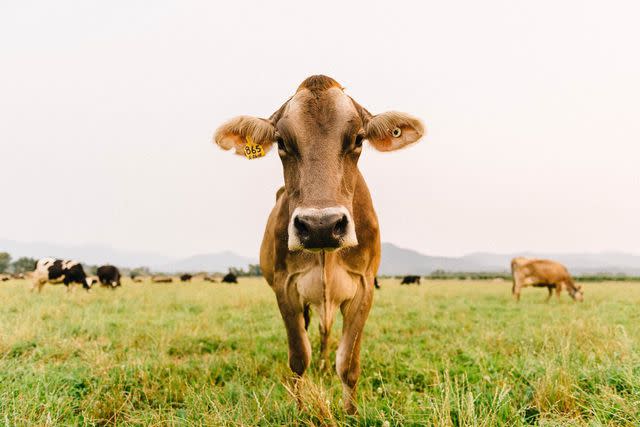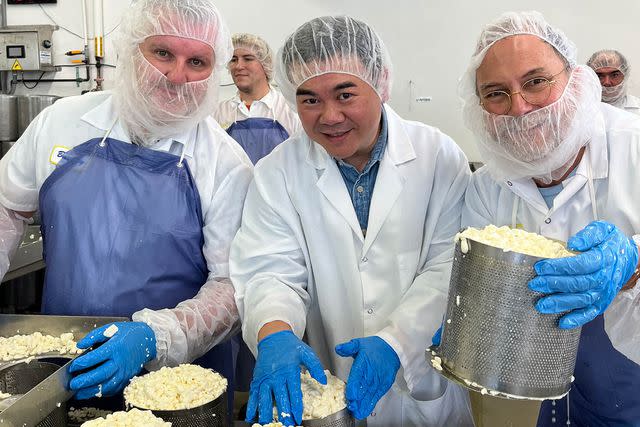There's Cheese Served at 36,000 Feet That Comes From Self-milking Cows — and You Can Find It on This Airline
It's been voted the best cheese in the world, and is served on a World's Best Award-winning airline.

Courtesy of Singapore Airlines
It's a Friday afternoon, and I'm standing next to four Singapore Airlines chefs marveling at an AI-powered cow-milking machine in Central Point, Oregon. There's a sentence I never thought I'd write.
I had been invited to join the chefs on an immersion trip to Singapore Airlines' newest culinary partner, Rogue Creamery, to get an inside look at the production of its award-winning cheese. The Rogue River Blue, named the best cheese in the world at the 2019/2020 World Cheese Awards, has been served on Singapore Airlines flights departing from the U.S. as part of the company's farm-to-plane initiative since April 2022. And I'm the first journalist to see the cheese-making process in action.
"It's very, very simple — it's beautiful food grown locally, as close to the airplane as possible," Singapore Airlines' global food and beverage director Antony McNeil tells me about the program over breakfast. "It's a reduction in our carbon footprint, reducing food miles and leading the customer experience to be holistic."
McNeil stumbled across Rogue Creamery on Instagram some three or four years ago and immediately suspected the company might be the right fit for the farm-to-plane program. The independent organic cheese maker is entering its 90th year of operation, the last 20 of which have been under the supervision of president and owner David Gremmels, who was responsible for developing Rogue River Blue. Rogue Creamery is not only built on sustainable practices — it was Oregon's first certified B Corp — but also innovation.
"In America, we're not grounded by tradition, so we can be really experimental in creating recipes," Gremmels says. "And so I created Rogue River Blue as a true expression of this valley."

H. Sterling Cross/Courtesy of Singapore Airlines
Everything that goes into the cheese is particular to the region. The milk, of course, comes from Rogue's herd of 129 self-milking (yes, really) cows, who reside at Rogue Creamery Dairy Farm on the banks of the Rogue River. The cheese is wrapped in the leaves of syrah grapes that are grown locally, which themselves are preserved in alcohol made from pears grown at local orchards.
As fantastic as that sounds on paper, McNeil takes the relationship between the World's Best Award-winning airline and Rogue Creamery one step further by bringing his team to the site to participate in the cheese-making process for a deeper understanding of why the companies have partnered. "It takes you back to why you became a chef in the first place," he says, noting that they get to experience unique flavor profiles at the source.
And that's how we find ourselves elbows deep in a 10,000-pound vat of cheese curds. Artisanal cheese making, as I find out, is a surprisingly manual process — part mad science experiment, part art form, and part workout. The curds, for instance, are cut by hand as cheesemakers drag metal grates across the vat, then stirred by hand with giant shovels. There is an automated agitator to make the process a little easier, but it's the human touch that ensures quality across the batch. And while some details are left to science — say, monitoring the pH levels of the whey — others, like deciding when the mold and bacteria growth in a wheel of cheese is at just the right point, is determined by years of hands-on experience.

Courtesy of Singapore Airlines
Singapore Airlines Chefs Antony McNeil and Ben Quang with Rogue Creamery Owner David GremmelsAfter our cheese-making experience, we took a short drive to Rogue Creamery's 68-acre dairy, where the cows reside in what's lightheartedly (and unofficially) referred to as the Cow Palace. The palace is, in fact, a custom-designed barn with excellent airflow, plenty of space for dining and sleeping, and, of course, those AI-powered milking machines.
The self-milking system is impressively sophisticated, monitoring the health and well-being of each and every cow while milking her. Ultimately, the system is designed to let the cows be milked on their own terms, at whatever time of day best suits their habits (the cows naturally want to be milked anywhere from three to six times per day).
When a cow is ready to be milked, she'll walk over to the machine and enter a small enclosure, where she's treated to a snack of grains. First, lasers and a camera map each cow's udder — the machine retains this information for easier connections for subsequent milkings. Then, the robotic arm attaches the milking cups to each teat. Before and after the process, the cow's udder is treated with iodine for sanitation.
During the milking process, the machine measures and records the quality of the milk, the rate of milk production in each cow, and when and how frequently the cow has come in for milking, among other stats. Consider it comparable to a health and fitness tracker on a smartwatch — it's all about data collection and analysis. All the data funnels into an app constantly monitored by staff, who ensure the cows are all happy and healthy at all times.
The chefs and I are all flabbergasted by this technology — I'm not sure that any of us knew that this type of milking system even existed. But I can assure you none of us will ever look at Rogue Creamery cheese the same way ever again.
So, the next time you're flying Singapore Airlines, take a closer look at the menu, and don't be afraid to ask your flight crew where a certain ingredient has come from. The answer might be vertical gardens in New Jersey or self-milking cows in Oregon. That's the farm-to-plane way.
For more Travel & Leisure news, make sure to sign up for our newsletter!
Read the original article on Travel & Leisure.

